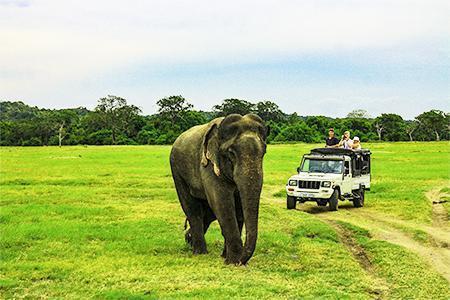Best time and popular spots
February to August
It is Sri Lanka’s second largest national park, with an area of 150,937ha. The park is divided into 5 sections. Two of the five blocks are open to the public. The park’s topography provides for a diverse species composition as well as good visibility. As a result, the park is quite popular.
Leopards, elephants, sloth bears, sambar, spotted dear, jackals, water buffaloes, crocodiles, and peacocks may all be found in Yala. There are 215 bird species documented in the park. The park contains the world’s largest concentration of leopards per square kilometer.
When the water levels in the park’s tanks are low between February and July, the animals congregate and travel freely in quest of water.
February to October
Wilpttu National Park is one of Sri Lanka’s oldest and most significant protected wildlife areas. It also has several significant cultural sites. The sanctuary is located inland from the ocean and has an 8-kilometer-long coastline.
The most conspicuous topographical feature of the 131,963 hectares national park is a unique collection of approximately 50 wetlands known as “Villu.”
The park hosts the country’s largest Leopard (Panthera pardus kotiya) population. A total of 31 mammal species have been identified including Sloth bears (Melursus ursinus), Asian Elephants (Elephas maximus), Spotted Deer, Barking Deer, Jackals, Sambhur, Mouse Deer, Wild Boar, and Water Buffalo. Mugger Crocodiles are top in the list of reptiles.
From November to March, it also serves as a stopover for a large number of migratory birds.
January to March
The Udawalawe National Park is Sri Lanka’s third most visited park. Udawalawe is one of the best sites in Sri Lanka to witness Asian elephants in the wild. There are around 500 elephants in the park, and they frequently travel in groups of up to 100 elephants.
Water Buffalo, Wildboar, Sri Lankan Axis Deer, Sambur Deer, Golden Jackal, Black-naped hare, Mongooses, Bandicoots, the endemic Toque Macaque and Tufted Grey Langur, Indian Muntjac, Sri Lankan Spotted Chevrotain, Asian Palm Civets, Golden Palm Civets, Indian Bush Rat, Rusty-spotted Cat, Fishing cats, and Jungle cats.
It is quite unusual to see a Leopard or a Sri Lankan Sloth Bear.
Udawalawe is a wide-open plain with a few dense jungles and teak woodland clumps.
May to September
The park is Sri Lanka’s second most visited national park and one of the most important ecosystems in the dry zone. From May through September, the greatest elephant gathering in Asia takes place in their native environment. During this period, hundreds of wild elephants from the surrounding forests visit the Minneriya reservoir and region for food and water.
August to December
Hills, large grasslands near the Kaudulla reservoir, woodland, and scrubland characterize the terrain. As an elephant corridor, Kaudulla connects Somawathiya and Udawalawe National Parks. As a result, Kaudulla National Park is crucial in maintaining the enormous number of elephants that are part of Minneriya National Park’s elephant gathering.


